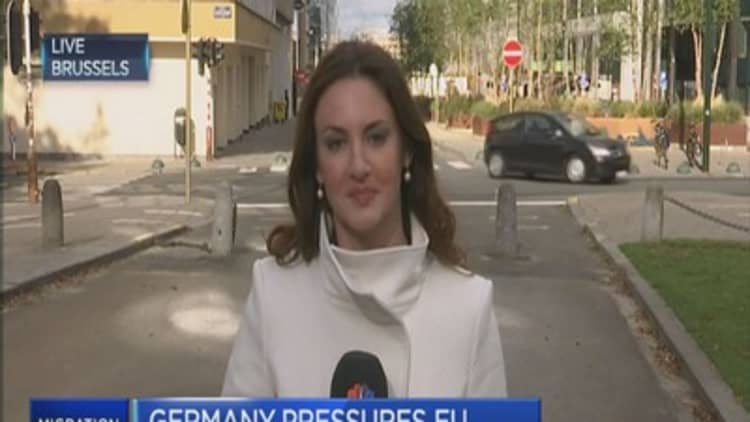Clashes broke out on Wednesday between police and migrants trying to enter the EU through Hungary's now-closed border with Serbia, as others opened up an alternative route via Croatia.
As Budapest stepped up its effort to halt a flow of people that its government has labelled a threat to the country's "Christian values", Hungarian riot police at the Roszke-Horgos crossing with Serbia fired tear gas and used water cannon to disperse crowds. Some migrants responded by throwing stones and bottles.
Wednesday's clashes came a day after Hungary enforced tough new controls making it a crime, punishable by imprisonment or deportation, to enter the country without a visa or proper paperwork.
Serbia, which expressed the "harshest possible protest" against Hungary over the use of tear gas, said it had been informed by Budapest that the crossing would be closed for 30 days.

But even as Hungary intensified its crackdown, neighbouring Croatia said it would allow migrants to pass through its territory, adding that 277 had entered from Serbia during the day.
Zagreb said landmine disposal experts had been sent to the border to reduce the risk of migrants being killed or injured by explosive devices left over from the 1990s conflict.
In a sign that the migrants were aware of the new route before arriving in the region, one Syrian in Turkey carried a map with Croatia and Slovenia carefully marked out in Arabic along a suggested course of travel.
"Croatia is entirely ready to receive or direct those people where they want to go, which is obviously Germany or Scandinavian countries," Zoran Milanovic, Croatia's prime minister, was quoted as saying by Reuters. "They will be able to pass through Croatia and we will help."
By contrast, Zoltan Kovács, spokesman for Hungary's government, said the scuffles at the border were "a sign that the migrants are not peaceful".
In the first trial of migrants accused under the new Hungarian law against illegal border crossing, an Iraqi who had fled Syria was excluded from the country for a year.
Hungary has, until now, served as entry point into the EU's Schengen area for tens of thousands of migrants who have headed north through Greece, Macedonia and Serbia.
But the flows have been disrupted and the free movement area put under severe strain by increased border controls along the migrants' route.
More from the Financial Times:
Migrant crisis sees border checks return to EU's Schengen area
Hungary chokes off flow of migrants into EU
Welcome migrants to solve skills shortage, say City bosses
These include restrictions on Germany's border with Austria introduced on Sunday, Hungary's subsequent clampdown on its Serbian frontier and Austrian controls at its own border with Hungary.
In the latest move, announced on Wednesday, Slovenia signalled that it would temporarily impose border controls with Hungary, a fellow Schengen member, while reinforcing the border with Croatia.
Many analysts and activists said the disruptions were sure to push the migrants on to other routes.
These include alternative paths through the Balkans or the dangerous Mediterranean crossing from Libya to Italy which, until this year, was the most travelled route.
"Normally when one route gets blocked or more difficult, migrants' first choice is to return to an old established route," said an official at Frontex, the EU's border control agency.
"We noticed even a couple of weeks ago there was a slight increase on the old routes, including the land route from Greece to Turkey [an alternative to the short but dangerous sea crossing from Turkey to Greek islands]".
There have even been reports that a small number of Syrians are heading through Russia to enter Norway through the Arctic Circle.
Read MoreEurope in disarray: Borders close amid migrant crisis
"The speed at which smugglers can establish new networks and new routes is not months but weeks," said John Dalhuisen, Europe and Central Asia director at Amnesty International, the campaigning human rights organisation.
"It is likely that some people will look again at the central Mediterranean route from Libya — we can predict a spike there — and people will be working on rival Balkan routes as we speak."
Some migrants already in Serbia may also seek to travel to Romania with the plan of then crossing into Hungary.
But Budapest announced plans on Tuesday to build a wire fence along a "reasonable" stretch of the 450km (280 mile) Romania-Hungary border, as it has done along its much shorter frontier with Serbia.
More than 9,000 people crossed over from Serbia to Hungary on Monday, but the number fell to just 366 on Tuesday.

